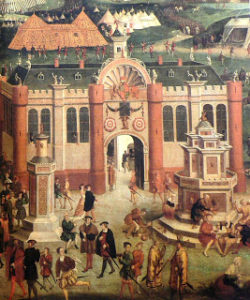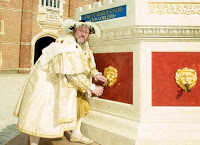A fully-working replica of  Henry VIII’s wine fountain has been installed at Hampton Court Palace in London and will flow with both red and white wine for visitors at weekends and bank holidays. It was built after the remains of a similar 16th century fountain were discovered during an archaeological dig at the palace a couple of years ago.
Henry VIII’s wine fountain has been installed at Hampton Court Palace in London and will flow with both red and white wine for visitors at weekends and bank holidays. It was built after the remains of a similar 16th century fountain were discovered during an archaeological dig at the palace a couple of years ago.
Wine fountains were popular in Tudor times – at Ann Boleyn’s coronation wine fountains were set up in Gracechurch Street, Cheapside and Fleet Street, and similar facilities were installed at Queen Elizabeth I’s coronation. In Oxford and Cambridge, the university colleges set up wine fountains when entertaining royalty.
The wine fountain at Hampton Court measures 14ft tall and has been made by traditional craftsmen using  timber, lead, bronze and gold leaf. It is decorated with 40 gilded lions’ heads.
timber, lead, bronze and gold leaf. It is decorated with 40 gilded lions’ heads.
It stands on the spot where Henry VIII’s octagonal fountain stood in Base Court and follows the design of a wine fountain taken from the painting “Field of the Cloth of Gold”. The painting is on show at Hampton Court.
The “Field of the Cloth of Gold” was a summit meeting in 1520 between Henry VIII and Francis I of France. The kings set out to impress and outshine each other, arriving at the meeting with large retinues.
In attempting to out show the other, the kings spared no expense in their displays of wealth.
They erected pavilions made with cloth of gold (real filaments of gold sewn with silk to make the fabric), organized jousts and other competitions of skill and strength, banqueted each other lavishly, in all ways trying to outdo and outspend one another. This ostentation earned the meeting the title “Field of the Cloth of Gold.”
In his contemporary account of the “Field of the Cloth of Gold”, Edward Hall, a Lond on lawyer, described “a fountain of enbowed work, gilt with fine gold, and bice [blue], ingrayled with antique works, the old God of wine called Bacchus burling the wine,
on lawyer, described “a fountain of enbowed work, gilt with fine gold, and bice [blue], ingrayled with antique works, the old God of wine called Bacchus burling the wine,
which by conduits in the earth ran to all people plenteously with red, white and claret wine, over whose heads was written in letters of Roman in gold “faicte bonne chere quy vouldra”.
The wine fountain at Hampton Court carries the inscription: “Make goode cheere who wyshes”.
The wine is being imported from the same area King Henry got most of his wine: Bordeaux. Henry VIII’s cellars contained up to 15,000 gallons at Hampton Court at any one time.
The Tudor s were familiar with wine from Spain, Germany and even Greece, but French wines were the favourite, particularly those from the former English possessions in Bordeaux and Aquitaine, according to Mark Meltonville, a food historian at Hampton Court.
s were familiar with wine from Spain, Germany and even Greece, but French wines were the favourite, particularly those from the former English possessions in Bordeaux and Aquitaine, according to Mark Meltonville, a food historian at Hampton Court.
“The thing that would surprise modern tastes is how young they drunk it,” he said. “From October they would have been drinking this year’s wine — like the Beaujolais Nouveau today.”
Such wines exported from Bordeaux were known as clairet, which is the French for “clear” and this is where our word claret comes from.
T he wines from Bordeaux at this period in time were much paler than the red wines of today as the result of a short fermentation, usually of no more than 1 or 2 days.
he wines from Bordeaux at this period in time were much paler than the red wines of today as the result of a short fermentation, usually of no more than 1 or 2 days.
As soon as the wine was fermented, it was run off into barrels, so the grape skins (which contain the colour and tannins) were left only a short time in contact with the juice. These wines didn’t last long, and were usually drunk very quickly.
They were lower in alcohol than today’ s wines – sometimes as low as 8 per cent alcohol.
Clairet is still produced in Bordeaux and has been rediscovered by the UK. The wines have great aromatic power and the bouquet is of ripe strawberries, blackberries and blackcurrants.
Depending on the style of the wine they can also have the zest of pomegranate, cranberry or raspberry – even plum.
The scents can be floral and are likened to peonies or roses. In the mouth they are voluptuous, velvety, rich, round, smooth and silky and the colours are luminous like jewels. If you are interested in trying some check out http://www.bordeaux-undiscovered.co.uk/.


